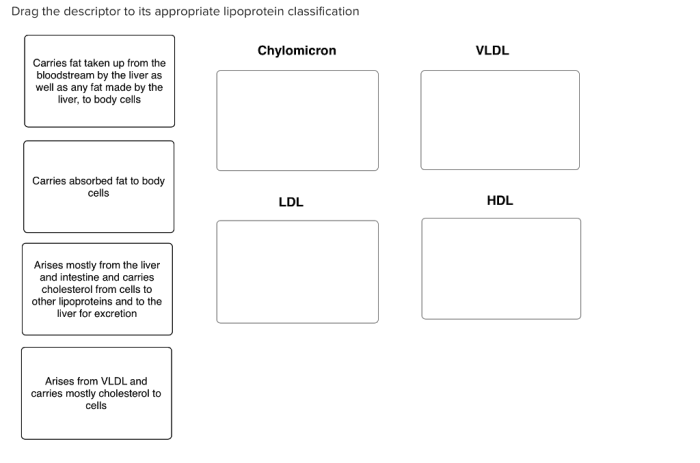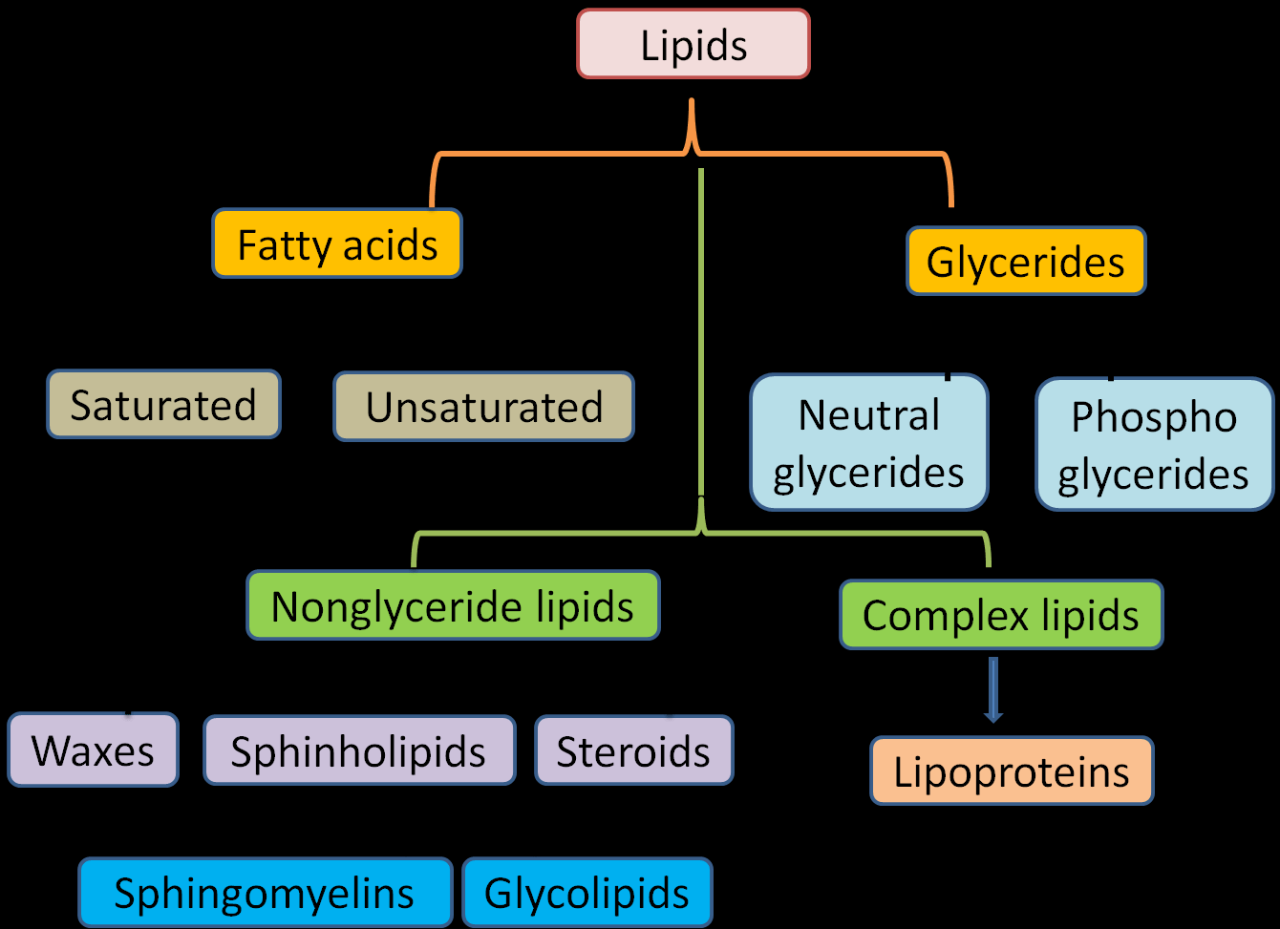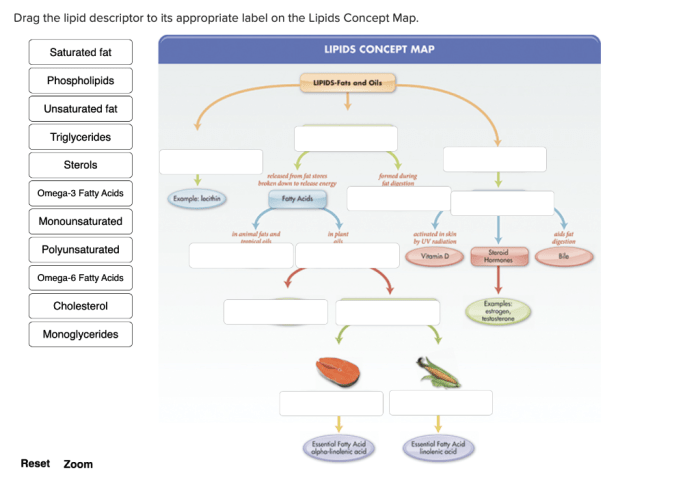Drag the descriptor to its appropriate fatty acid classification. This interactive activity engages learners in the classification of fatty acids based on their chemical structures and properties. By dragging and dropping descriptors such as “saturated,” “monounsaturated,” and “polyunsaturated,” learners gain a deeper understanding of the diverse characteristics of fatty acids.
The activity is designed to reinforce key concepts related to fatty acid structure, nomenclature, and their significance in human health. Learners will explore the differences between saturated, monounsaturated, and polyunsaturated fatty acids, and their implications for dietary choices and overall well-being.
Saturated Fatty Acids

Saturated fatty acids are characterized by their straight hydrocarbon chain with no double bonds between carbon atoms. They are typically solid at room temperature and have a high melting point. Saturated fatty acids are primarily found in animal products, such as meat, butter, and cheese.
Examples of Saturated Fatty Acids
- Palmitic acid
- Stearic acid
- Myristic acid
- Lauric acid
Health Effects of Saturated Fatty Acids
| Fatty Acid | Melting Point (°C) | Solubility | Health Effects |
|---|---|---|---|
| Palmitic acid | 62.9 | Insoluble in water | Increased risk of cardiovascular disease |
| Stearic acid | 69.6 | Insoluble in water | Neutral or slightly beneficial effects on cardiovascular health |
| Myristic acid | 54.4 | Insoluble in water | Increased risk of cardiovascular disease |
| Lauric acid | 43.8 | Insoluble in water | Antimicrobial properties |
Monounsaturated Fatty Acids

Monounsaturated fatty acids have a single double bond between carbon atoms. They are typically liquid at room temperature and have a lower melting point than saturated fatty acids. Monounsaturated fatty acids are found in both plant and animal products, such as olive oil, avocados, and nuts.
Chemical Structure and Properties
The double bond in monounsaturated fatty acids creates a “kink” in the hydrocarbon chain, which prevents the molecules from packing tightly together. This results in a lower melting point and higher fluidity compared to saturated fatty acids.
Health Benefits of Monounsaturated Fatty Acids
Monounsaturated fatty acids have been linked to several health benefits, including:
- Reduced risk of cardiovascular disease
- Improved blood cholesterol levels
- Reduced inflammation
- Enhanced brain function

Polyunsaturated Fatty Acids

Polyunsaturated fatty acids have multiple double bonds between carbon atoms. They are typically liquid at room temperature and have a very low melting point. Polyunsaturated fatty acids are found in plant-based oils, such as soybean oil, corn oil, and flaxseed oil.
Omega-3 and Omega-6 Fatty Acids
Polyunsaturated fatty acids are classified into two main groups: omega-3 fatty acids and omega-6 fatty acids. Omega-3 fatty acids are considered essential fatty acids, meaning that they cannot be synthesized by the body and must be obtained from the diet.
| Fatty Acid Type | Sources | Health Effects | Recommended Intake |
|---|---|---|---|
| Omega-3 fatty acids | Fish, flaxseed oil, walnuts | Reduced risk of cardiovascular disease, improved brain function | 2-3 servings of fatty fish per week |
| Omega-6 fatty acids | Vegetable oils, nuts, seeds | Inflammation, cardiovascular disease (in excess) | 1-2 teaspoons of vegetable oil per day |
Tips for Incorporating More Polyunsaturated Fatty Acids into the Diet
- Choose fatty fish, such as salmon, tuna, or mackerel, as your primary protein source.
- Use plant-based oils, such as olive oil or avocado oil, for cooking and salad dressings.
- Include nuts and seeds, such as walnuts, almonds, and flaxseeds, in your snacks and meals.
Trans Fatty Acids

Trans fatty acids are unsaturated fatty acids that have been chemically altered through a process called hydrogenation. Hydrogenation adds hydrogen atoms to the double bonds in unsaturated fatty acids, making them more saturated and solid at room temperature.
Health Risks of Trans Fatty Acids
Trans fatty acids have been linked to several health risks, including:
- Increased risk of cardiovascular disease
- Increased LDL (bad) cholesterol levels
- Reduced HDL (good) cholesterol levels
Regulations and Labeling Requirements
Many countries have implemented regulations to limit the use of trans fatty acids in food products. In the United States, the Food and Drug Administration (FDA) has banned the use of partially hydrogenated oils, which are the primary source of trans fatty acids in the food supply.
Essential Fatty Acids
Essential fatty acids are fatty acids that cannot be synthesized by the body and must be obtained from the diet. There are two essential fatty acids for humans: linoleic acid (omega-6) and alpha-linolenic acid (omega-3).
Sources, Functions, and Deficiency Symptoms, Drag the descriptor to its appropriate fatty acid classification.
| Fatty Acid | Sources | Functions | Deficiency Symptoms |
|---|---|---|---|
| Linoleic acid | Vegetable oils, nuts, seeds | Cell membrane structure, hormone production | Eczema, hair loss, impaired wound healing |
| Alpha-linolenic acid | Flaxseed oil, walnuts, chia seeds | Brain development, eye health | Dry skin, fatigue, impaired immune function |
Questions and Answers: Drag The Descriptor To Its Appropriate Fatty Acid Classification.
What are the different types of fatty acids?
Fatty acids are classified into three main types: saturated, monounsaturated, and polyunsaturated.
What is the difference between saturated and unsaturated fatty acids?
Saturated fatty acids have no double bonds between carbon atoms, while unsaturated fatty acids have one or more double bonds.
What are essential fatty acids?
Essential fatty acids are fatty acids that cannot be synthesized by the body and must be obtained from the diet.